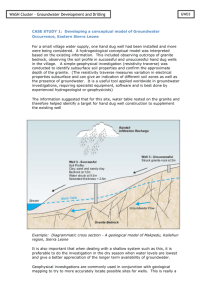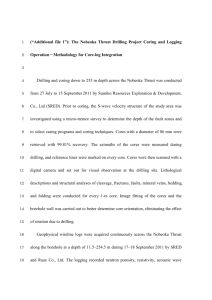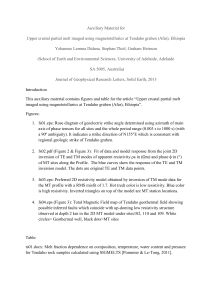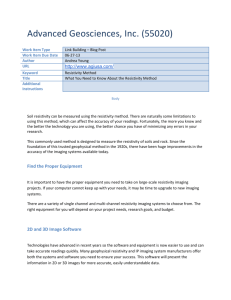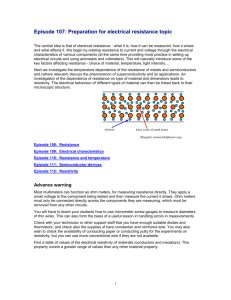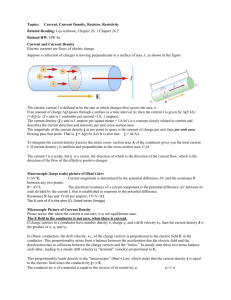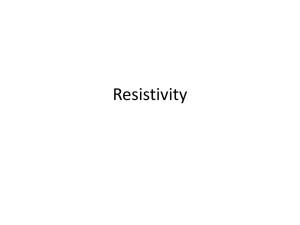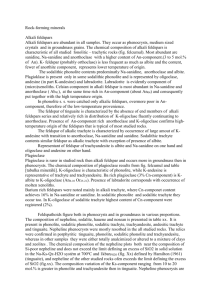UPPER HILL KIPKORGOT COMMUNITY BOREHOLE
advertisement
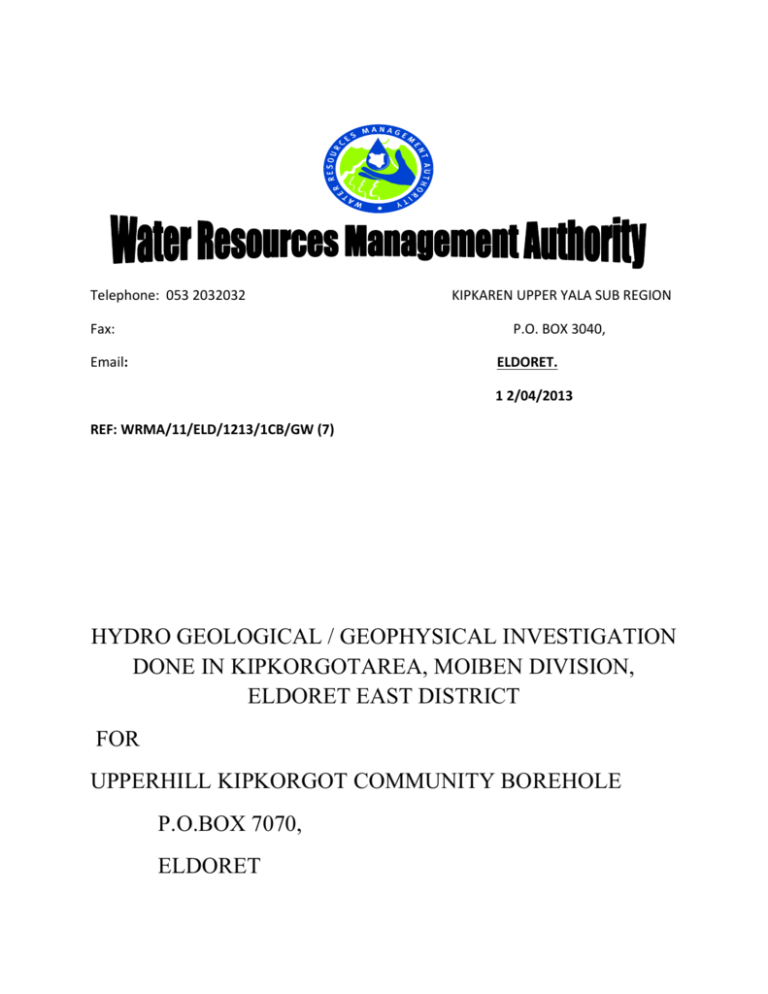
Telephone: 053 2032032 Fax: KIPKAREN UPPER YALA SUB REGION P.O. BOX 3040, Email: ELDORET. 1 2/04/2013 REF: WRMA/11/ELD/1213/1CB/GW (7) HYDRO GEOLOGICAL / GEOPHYSICAL INVESTIGATION DONE IN KIPKORGOTAREA, MOIBEN DIVISION, ELDORET EAST DISTRICT FOR UPPERHILL KIPKORGOT COMMUNITY BOREHOLE P.O.BOX 7070, ELDORET EXECUTIVE SUMMARY The report details the findings of hydro geological/ geophysical investigations carried out at the client’s plot in Kipkorgot area, moiben Division in Eldoret East District. The main objective of the study was to execute hydro geological and geophysical surveys in order to discern the subsurface geological conditions and determine nature of the underlying layers and thus groundwater potential in the area. Geological Set – up Kipkorgot area is situated in Uasin Gishu which is part of western Zone of Rift Valley where phonolite lavas are resting directly on the basement system of rocks. On top of the basement the geology comprises tuffs phonolite, agglomerates and sediments. Geophysical investigation The study approach involved desk study and analysis of various documents. These included base maps, topographical maps and geological covering the study area and the surrounding areas. An ABEM terrameter instrument was used to obtain data during this field work. The geophysical investigations were mainly aimed at the determination of the depth and nature of the layers and geological boundaries. One VES measurement was executed at a selected potential point using expanding schlumberger array, with electrode spread of up to AB/2=250 The geophysical investigation has identified the various geological layers in the project area. These included a thin layer of top soils, an overburden representing near surface layers, a conductive layer (weathered and highly weathered/ fractured) volcanic and a slightly weathered formation grading to fresh rock i.e. the upper part of the resistive substratum. The VES together with the resistivity modeled results indicate that the project area has considerable groundwater. It is therefore recommended that a borehole be drilled at the selected point of VES R272010 to a possible maximum depth of 200 meters. PROJECT SUMMARY Clients name and address UPPERHILL KIPKORGOT COMMUNITY BOREHOLE,BOX 7070,ELDORET Description This application is for drilling of a borehole for domestic water supply purposes. It is to be located within the client’s farm in Kipkorgot area, Moiben Division, Eldoret East district. Geology Kipkorgot area is situated in Uasin Gishu which is part of Western Zone of Rift Valley where phonolite lavas are resting directly on the basement system of rocks. On top of the basement the geology comprises tuffs phonolite, agglomerates and sediments. Current Water source At present the community relies on water from shallow wells dug at every homestead which dry up during dry season. In this regard the community wishes to utilize groundwater by drilling a borehole in order to mitigate water shortage. Location of proposed borehole site To be drilled within the clients plot at the recommended point to a possible maximum depth of 200 meters and defined by GPS readings: N: N00.48639 and E: 035.34418 at an altitude of 2188m. Recommended drilling depth 200 meters Expected yield: 1 – 6.0m3 /hr but this is likely to improve with careful construction and proper well development. 1.0 INTRODUCTION 1.1 Background Kipkorgot community (the client) commissioned Water Resource management Authority to carry out ground water investigations/ hydro geological study at their farm in Kipkorgot area, Eldoret East District to asses’ ground water potential. The intention of the client is to sink borehole to supply water for domestic purposes .At present the client does not have a reliable source of water supply. In this regard the client wishes to utilize groundwater by drilling a borehole in order to meet their daily water demand. It is estimated that 20m3 of water per day would be adequate. Geophysical and hydro geological investigations were conducted within the plot to identify the most suitable site for the proposed borehole. The results of geophysical investigations coupled with other relevant information gathered during the fieldwork are detailed in this report. The objectives of this study in addition to identifying a suitable location for the proposed potential aquifers, possible yields and water quality in addition to recommending optimum drilling depth at the selected site. 1.2 Location The project area is located within the client’s farm in Kipkorgot area, Eldoret East District. It lies within the 1:50,000 survey of Kenya topographic sheet for kaptagat (No.103/2). GPS readings are N00.48639, E: 035.34418 and altitude of 2188m, amsl. 1.3 Objectives and scope The aim of the investigations is to assess the availability of groundwater and to advice on the viability of drilling a borehole or other water supply alternatives. The main objective of the study was to execute hydro geological survey in order to discern the subsurface geological conditions and nature of the underlying layers and determine depth to bedrock. The detailed tasks include: a) To carry out hydro geological investigations to establish the groundwater occurrence and distribution in the project area. b) To execute geophysical surveys to identify the subsurface conditions for the appropriate locations of boreholes and shallow wells. c) To analyze all data pertaining to hydro geology, geophysics and reports thereon. 1.4 Approach The study was carried out in the following steps: Desk review of the existing hydro geological, hydrological and other relevant data of the area. Assessment of the prospects for groundwater development in the area and the feasibility of drilling a borehole. Selecting the most suitable location for borehole drilling taking into account the prospect for sustainable abstraction, water quality parameters and social aspects. 1.5 Physiography, drainage and vegetation The Physiography of the project area is largely characterized by the Uasin Gishu plateau which is part of western Zone of the Rift valley. The farm rests on an undulating land that gently slopes westwards. The drainage system in an area is strictly dependent on the slope, the nature and attitude of bedrock and on the regional and local fracture pattern. Drainage, which is easily visible on the map of the area, therefore reflects to varying degrees the lithology and structure of a given area can be of great value for groundwater resources evaluation. The drainage in this area is largely characterized by stream flow over the undulating land that ends up in Kipkarren River. The general flow direction is northwards and this is likely to be the groundwater flow direction. The vegetation found in the area include indigenous and some exotic trees. Their coverage is fair, which facilitates percolation of precipitation into the ground, thus ensuring good recharge of the groundwater resources. Rainfall season in the project area exhibits bimodal type of rainfall whereby long rains start in mid march and end in late may while short rains from August to May. Dry spell is experienced from December to Mid march. Annual rainfall for the area is predominantly 1100mm. Geology, Hydrogeology and water quality 1.6 General geology kipkorgot area is situated in Uasin Gishu which is part of western Zone of rift valley where phonolite lavas are resting directly on the basement system of rocks. On top of the basement the geology comprises tuffs phonolite, agglomerates and sediments. 1.7 Hydrogeology Kipkorgot area is covered by black cotton soils which overlie Uasin Gishu phonolite. The phonolite lavas are underlain by Gneisses of the basement rock system. Potential aquifers are found within fractured and jointed zones and recharge of the same aquifers is mainly by lateral percolation of rainwater which averages 1100mm annually. There are some boreholes drilled in the same geologic set up and their details are tabulated below. Borehole Serial No. –c1870 Distance (Km) and directions 5km/ north Total depth (m) Water rest land (m) Tested yield m3 / hr 106.71 Water Struck level (m) 74.48 18.29 7.73 1577 6 km / north/East 42.67 35.06 26.83 12.0 1.8 Groundwater Recharge Where rainfall, runoff, soil moisture charges and evapo – transpiration data is known, the amount of water which is yearly added to the permanent ground can be estimated (recharge). For an accurate water balance calculations, very precise and extensive hydro geological data of the concerned area is required, which is rarely available. The recharge mechanisms (and the rate of replacement) of the local aquifers has not been fully established. The two major processes are probably direct recharge at surface (not necessarily local) and indirect recharge via faults and or other aquifers. Direct recharge is obtained through downward percolation of rainfall or river water into aquifer. If the infiltration rate is low due to the presence of an aquiclude (such as clay), the recharge to the aquifer is low. Percolation will depend on the soil structure, vegetation cover and the state of erosion of the parent rock. Rocks weathering to clay soils naturally inhibit infiltration and downward percolation. Aquifers may also be recharged laterally if the rock is permeable over a wide area. The ground water recharge in the project area is mainly through infiltration and subsequent percolation of the annual rainfall in addition to regional lateral replenishment. Potential aquifers are expected at fractured/ weathered, old land surfaces, decomposed, faulted or jointed zones of the above rocks. 1.9 Discharge Discharge paths in the investigated area are reflected in geology, land use and cover type and fall into one of the following categories: Interception, transpiration and evaporation of rainfall; this covers all losses from rainwater before it leaves the rainfall part of the hydrological cycle and becomes either run off or percolation water. Discharge from aquifers is either through natural processes as base flow to streams and springs, or artificial discharge through human activities. Some of the percolated water in the project area is also lost through the springs in lower valleys. From the hydro geological study, the total effective discharge from the aquifer via either of the above means for this area is not available. 1.10 Water Quality All types of water i.e. run – off water, groundwater and rainwater, contain some dissolved salts and impurities. If certain elements are present in quantities above maximum allowable limits, the application of the water to domestic use or other purposes may have adverse effects. The quality of groundwater occurring within the volcanic of the study area range from mineralized to good. However this is subjective and water samples have to be submitted for full bacteriological and chemical analysis. The main purpose of a water quality analysis is to determine the suitability of water for a proposed use. The three main classes of water use are domestic, Agricultural and industrial. A supply intended for public use may include all the three classes and according requires a standard of quality that is generally higher than that needed for any one class. Water for use in a particular industry may require a quality that is substantially higher than the one required by a public supply. Permanent measures for the protection of groundwater are required in the immediate vicinity of the proposed borehole and also its catchment area. The danger of contaminating groundwater quality is correspondingly increased by factors such as negligence, population density and over abstraction. Data obtained from boreholes drilled around Kipkorgot center indicate that the quality of groundwater is generally good. These boreholes have been drilled in the same geological formation as the present study area and therefore by inference the groundwater quality within the client’s farm is expected to be equally good. The proposed drill site and related works are expected to pose no impact on water quality, either surface or groundwater resources. There is no any surface water body near the drill site that can be contaminated by waste waters generated during drilling. It is expected that the entire drilling, borehole construction, pump tests and completion works will be done under the supervision of a qualified hydro – geologist to professional standards. Entry of any foreign material until completion should be avoided to avoid any entry of foreign material into the borehole and only inert materials should be used in construction. Monitoring of electrical conductivity during drilling is recommended in order to detect any aquifer with possibly elevated mineralization. 2.0 GEOPHYSICS – RESISTIVITY METHOD 2.1 Basic principles of the resistivity method The resistivity of earth materials can be studied by measuring the electrical potential distribution produced at the earth, s surface by an electric current that is passed through the earth. The residence ‘R ‘of a certain materials is directly proportional to its length L and inversely proportional to its cross – sectional area A, expressed as: R = Ω*L/A Ω (1), Where Ω is the specific resistivity, characteristic of the material and independent of its shape or size. With Ohms Law. R = ΩV/I Ω (2), Where Ω is the potential difference across the resistor and I is the electric current through the resistor, the specific resistivity may be determined by: Ω = (A/L) * (ΩV/I) (Ωm) (3) The electrical properties of rocks in the upper part of the earth’s crust are determined by the lithology, porosity, and the degree of pore space saturation and the salinity of any pore water. These factors all contribute to the resistivity of a material (the reciprocal of the electrical conductivity). 2.2 Resistivity sounding technique When carrying out a resistivity sounding, also called vertical electrical sounding (VES), an electric current (I) is passed into the ground through two metal stakes, the current electrodes. Subsurface variations in electrical conductivity determine the pattern of current flow in the ground and thus the distribution of electrical potential. A measure if this is obtained in terms of the voltage drop (ΩV) between a second pair of usually metal stakes, the potential electrodes placed near the center of the array. The ratio (ΩV/I) provides a direct measurement of the ground resistance and from this, and the electrode spacing, the apparent resistivity (Ωa) of the ground is calculated. The measuring setup consists of a resistivity instrument (usually placed in the middle of the array) allows the flow of current to penetrate progressively greater depths. The apparent resistivity is a function of the electrode separation AB and provides information on the vertical variation in resistivity. The depth of penetration varies according to the electrode array, but is also affected by the nature of the material beneath the array. The point at which a change in earth layering is observed depends on the resistivity contrast, but is generally of the order of a homogenous medium the depth penetration is of the order 0.12 AB (Roy & Apparol 1971) The calculated apparent resistivity is plotted against current electrode half separation on a bi – logarithmic graph paper to constitute the so called “Sounding curve”. The curve depicts a layered earth model composed of individual layers of specific thickness and resistivity. Interpretation of field data can be done with hand – fitted curves, but this method is time consuming and practically limited to 3 – layer solutions. Modern interpretation is computer – aided, using a curve fitting procedure based on a mathematical convolution method developed by Ghosh (1971). 2.3 Geo – electrical layer response Vertical electrical soundings (VES) provide quantitative information on electrical resistivity as a function of depth. The computer – interpretation of the sounding data produces a layered model of the subsurface. The derived resistivity layers are used to infer their texture, weathering, fracturing, salinity as well as presence of water – bearing strata. In the presence of clays and conductive minerals the resistivity of the rocks is reduced (low). Water –bearing and /or weathered rocks have lower resistive than unsaturated (dry) and/ or fresh rocks. The higher the porosity of the saturated rock, the lower its resistivity, and the higher the salinity (or electrical conductivity EC) of the saturating fluids, the lower the resistivity. The relation between the formation resistivity (‽) and the salinity is given by the “Formation Factor” (F): ‽ = Fx ‽w = F x10, 000 / EC (µS/cm), where ‽w = resistivity of the pore water In sediments, or unconsolidated layers produced by weathering, the formation factor varies between 1 (for sandy clays) and 7 (for coarse sands). 2.4 Limitations While the resistivity method is a useful tool in geophysical investigations its applicability and reliability should not be overestimated. The modeling of field data is often attended by problems of equivalence and suppression: a) Equivalence: the similar geophysical properties of layers with contrasting hydrogeological characteristics (e.g. clay layers and layers with brackish water), each curve has an infinite number of possible solutions with different layer resistivity and depths. Mathematical convolution can easily lead to a well fitting solution, which nonetheless does not correspond to reality. In general, the number of possible solutions is reduced by mutual correlation of several sounding curves, knowledge of the local geology and drilling data. b) Absence of distinct layer boundaries: the decreasing degree of weathering with depth is usually not well-defined, but gradual. This results in a gradual increase in resistivity, and not in a distinct set of geophysical layers. c) Suppression; when deposits with similar resistivity border each other, it is usually not possible to make a differentiation. Intermediate layers, occurring between deposits of contrasting conductivity, may go undetected, as they tend to be obscured within the rising or falling limb of the sounding graph; It should be noted that the layered earth model is very much a simplification of the many different layers, which may be present. The various equivalent solutions, which can be generated by a computer programme, should therefore be carefully analyzed. In general, resistivity soundings should never be interpreted in isolation as this may lead to erroneous results. 2.5 Interpretation of the data The resistivity data collected were correlated with mean resistivity of the rock formation as established during previous investigations in the area and other neighboring areas but with similar geological set – up. 2.6 GEOPHYSICAL FIELDWORK 2.6.1 Field work The hydrogeological reconnaissance and field visits to the area was carried out in December, 2010. An ABEM Terrameter instrument was used to obtain data during this fieldwork. The geophysical investigations were mainly aimed at the determination of the depth and nature of the layers and geological boundaries. 2.7 results and discussion To assess the sub – surface characteristics suitable for groundwater storage, one vertical electrical sounding R272010 was conducted at Community land parcel. The data from survey is interpreted and tabulated below. Sounding Curve No. Depth expected formation (m) True resistivity ohm - m Expected geologic formation R272010 0-5 800 Dry Top soils 5 – 20 20 highly weathered phonolite 20 – 40 50 Highly weathered phonolite 40 – 80 100 80-100 150 fratured phonolite 100-160 200 Fractured phonolite 160-tends to infinity 250 Fractured phonolite which grades to fresh with depth. weathered phonolite 3.0 Conclusion / recommendation From the data of existing boreholes, results of geophysical survey and other hydrogeological considerations, it is evident that this place is of moderate ground water potential. It is therefore recommended that a borehole be authorized for drilling at site R272010 to a maximum depth of 200m. NOTE: The client should note that before the drilling commences, authorization to drill a borehole must be obtained from the water Resources Management Authority On completion of the borehole, a borehole completion report must be submitted to the same Authority for the issuance of a permit. An authorization is not a permit. The investigated site is approximately shown on the attached map extract. Leonard Masafu Investigating Geologist.
